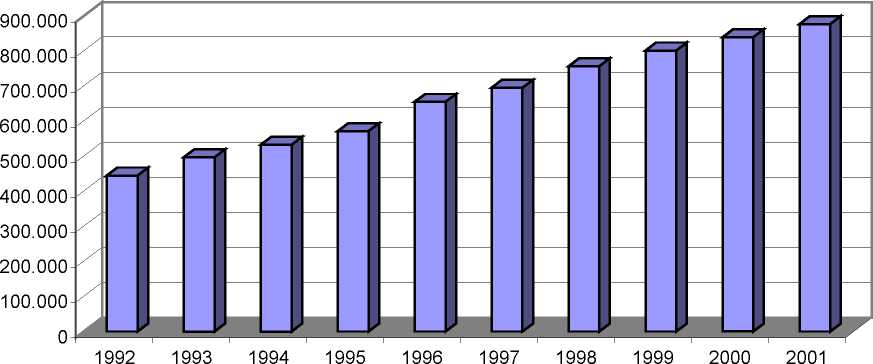Access11
A first raw indicator of the evolution of the industry is provided in Figure 3.1. It shows the total
number of electricity consumers in the country for the period 1992-2001. Total number signifies
consumers within the National Interconnected System (NIS)12 and those not part of the NIS.
Figure 3.1
Total Number of Residential Consumers

Source: National Institute of Statistics of Bolivia (INE)
As shown in figure 3.1 above, a growth rate of over 97% on electricity consumers is experienced
between 1992 and the year 2001. Closer inspection of the yearly evolution of electricity
consumers shows that the growth rate after the year 2001 should decrease due to the fact that
urban consumption will peak soon - data above corresponds to approximately 90% urban
coverage - which would force rural growth to take over in the not so distant future. Since rural
Bolivia is, on average, poorer than urban Bolivia, overall growth rates are expected to slow down.
11 There are small discrepancies in data obtained from different sources - between bolivian institutions and with
sources outside Bolivia. This is particularly evident for prices. While discrepancies are small, the reader should note
that they exist.
12 The National Interconnected System (NIS) is the interconnected electric system that supplies electricity to the
Departments of La Paz, Cochabamba, Santa Cruz, Oruro, Chuquisaca and Potosi. Bolivia is divided into 9
Departments - just like other countries are divided into States or Provinces - hence the NIS covers 6 of the 9, which
are considered to be the biggest users of electricity in the country.
10
More intriguing information
1. PRIORITIES IN THE CHANGING WORLD OF AGRICULTURE2. Exchange Rate Uncertainty and Trade Growth - A Comparison of Linear and Nonlinear (Forecasting) Models
3. Public-Private Partnerships in Urban Development in the United States
4. How we might be able to understand the brain
5. The name is absent
6. The name is absent
7. Testing Hypotheses in an I(2) Model with Applications to the Persistent Long Swings in the Dmk/$ Rate
8. Visual Perception of Humanoid Movement
9. Nonparametric cointegration analysis
10. O funcionalismo de Sellars: uma pesquisa histδrica